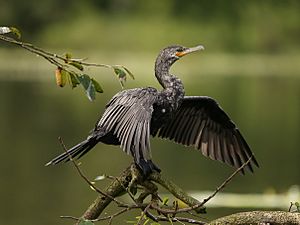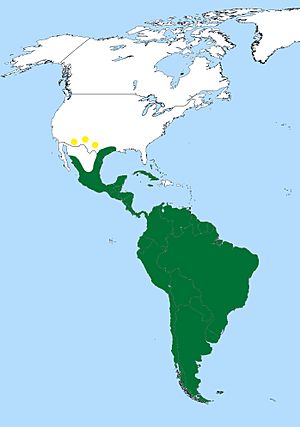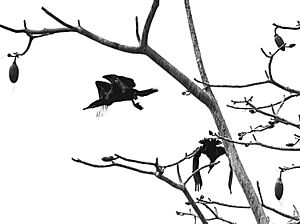Neotropic cormorant facts for kids
Quick facts for kids Neotropic cormorant |
|
|---|---|
 |
|
| Conservation status | |
| Scientific classification | |
| Genus: |
Phalacrocorax
|
| Species: |
brasilianus
|
 |
|
| Range of Phalacrocorax brasilianus Accidental occurrence Resident | |
| Synonyms | |
|
Phalacrocorax olivaceus (Humboldt, 1805) |
|
The Neotropic Cormorant (Phalacrocorax brasilianus), also called the Olivaceous Cormorant, is a medium-sized water bird. You can find these birds in warm parts of the Americas. They live from the southern United States all the way down to southern South America. They also live on islands like the Bahamas, Cuba, and Trinidad. These cormorants can be seen both along coasts, including mangrove areas, and in fresh water like rivers and lakes. In Peru, some people called the Uru use these birds to help them fish!
Contents
How It Got Its Name
This bird was first written about in 1658 by a person named Willem Piso. He had traveled in Brazil. This information helped Johann Friedrich Gmelin describe and name the species in 1789. For a long time, many experts preferred to use the name Phalacrocorax olivaceus. This name came from Alexander von Humboldt's description in 1805. People thought Piso's original description might not be clear enough. But recently, many bird groups, like the American Ornithologists' Union, have started using Phalacrocorax brasilianus again. This is because M. Ralph Browning showed that Piso's notes and pictures really do describe the Neotropic Cormorant.
What They Look Like
This bird is about 64 centimeters (25 inches) long. Its wings can spread out to about 100 centimeters (39 inches). Adult male Neotropic Cormorants weigh between 1.1 to 1.5 kilograms (2.4 to 3.3 pounds). Females are a bit lighter, weighing 50 to 100 grams (1.8 to 3.5 ounces) less. Birds living in the southern parts of their range tend to be larger than those in the north.
The Neotropic Cormorant is smaller and thinner than other cormorants, like the Double-crested Cormorant. It has a long tail. It often holds its neck in an S-shape. Adult birds are mostly black. They have a yellow-brown patch on their throat. When it's breeding season, they get white tufts on the sides of their head. They also have scattered white feathers on their head and neck. The throat patch gets a white edge. The upper parts of their wings are a bit grayer than the rest of their body. Young Neotropic Cormorants are brownish.
-
Rodrigo de Freitas Lagoon, Brazil
Behavior and Life
What They Eat
The Neotropic Cormorant mainly eats small fish. But they also eat tadpoles, frogs, and water insects. We don't know a lot about all the different things they eat. However, birds living inland seem to eat small, common fish from ponds and calm waters. These fish are usually less than 10 centimeters (4 inches) long and weigh only a gram or two. An example is the sailfin molly.
This cormorant hunts for food by diving underwater. It uses its feet to push itself through the water. Its dives are short, lasting only 5 to 15 seconds. Sometimes, these cormorants hunt in groups. Several birds will beat the water with their wings. This helps to drive fish into shallow areas where they are easier to catch.
Reproduction and Life Cycle
Neotropic Cormorants are monogamous, meaning they stay with one partner. They build their nests in large groups called colonies. The nest is a platform made of sticks. It has a dip in the middle that is lined with twigs and grass. Nests are built a few meters (several feet) above the ground or water in bushes or trees.
A female cormorant can lay up to five chalky, bluish-white eggs. Most pairs lay three eggs. However, usually fewer than two eggs hatch successfully. The eggs can quickly become stained from the nest. Both the male and female birds take turns sitting on the eggs. This incubation period lasts about 25 to 30 days. Both parents also feed the young birds until they are about 11 weeks old. By the time they are 12 weeks old, the young cormorants can take care of themselves. These birds usually raise one group of young each year.
Other Habits
Unlike some other cormorants, the Neotropic Cormorant can often be seen sitting on power lines. Most of these birds stay in the same area all year round. However, some birds might travel north during the warmer months.

Neotropic cormorant species account at Neotropical Birds (Cornell Lab of Ornithology) Citizen science observations for Neotropic cormorant at iNaturalist
See also
 In Spanish: Cormorán neotropical para niños
In Spanish: Cormorán neotropical para niños





